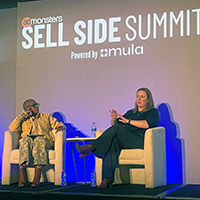 A frictionless digital experience has long been the holy grail for marketers. But according to a new report from Gartner, introducing some “productive friction” into customers’ digital journey could increase sales and brand loyalty. In this way, marketers are “no longer digital order-takers but become digital orchestrators,” says Kristina LaRocca-Cerrone, Director, Advisory in the Gartner for Marketers practice.
A frictionless digital experience has long been the holy grail for marketers. But according to a new report from Gartner, introducing some “productive friction” into customers’ digital journey could increase sales and brand loyalty. In this way, marketers are “no longer digital order-takers but become digital orchestrators,” says Kristina LaRocca-Cerrone, Director, Advisory in the Gartner for Marketers practice.
In the report “What Marketers Need to Know to Make Digital Experiences Pay Off,” Gartner cites a survey of 3,013 consumers in which 46 percent couldn’t differentiate among the online and mobile experiences offered by most brands. One reason: Efficient digital experiences requiring a minimum of clicks—which brands have long strived for—are almost by definition similar to one another.
That’s not to say that marketers should introduce digital speedbumps throughout the customer journey simply to set themselves apart. After all, a brand doesn’t want to be known for being cumbersome. Rather, friction should be judiciously added to boost efficacy. This ties in with another finding from Gartner’s customer survey: Not only did 58 percent believe that their digital experiences had no effect on their purchase decision, but just 14 percent actually took a “course-changing” action after a digital experience.
LaRocca-Cerrone defines a course change as not just an unanticipated action—making a purchase when one was visiting a website merely to browse, for instance. It is an unexpected action that an individual performed “with confidence,” she explains. “These customers will agree with statements like ‘The experience I had with Acme Brands caused me to take action in how I solve a problem or achieve a goal’ or ‘After my experience with Acme Brands I feel confident in my purchase or choice or I changed my perspective.’ They feel more confident about themselves, their decision-making.”
And when consumers have digital experiences that make them feel that way, they’re more likely to remember the brand, be loyal to it and even become an advocate of it. Whereas 21 percent of the consumers surveyed said that product value led them to become advocates of a brand, 54 percent credited a course change for their brand advocacy.
To facilitate course changes, marketers need to encourage “moments of self-reflection and self-engagement,” LaRocca-Cerrone says. Such moments require consumers to slow down amid their digital journey—and marketers have long equated slowing the digital experience with losing consumers. That’s why you need to distinguish between automatic tasks and self-reflective tasks. Ideally, she says, a digital experience should feature both.
Automatic tasks “are basically things that are transactional,” LaRocca-Cerrone says. These include locating already decided-on products, finding product information that validates the purchase decision and making the purchase. A self-reflective task might be a quiz that helps consumers determine which of the various options is their best choice.
LaRocca-Cerrone cites the “My Priorities” quiz from financial services firm Edward Jones as a particularly good example. Rather than simply ask prospective buyers what their primary financial goal is, the quiz is engineered to help them rank multiple goals. “It’s a little bit uncomfortable,” she says. “All the choices are good choices, but you have to grapple with these uncomfortable tradeoffs. The tradeoff nature of the conjoint analysis lets you learn a little more about yourself.”
As well as encouraging consumers to reflect on what is truly most important to them, this tactic sets Edward Jones apart by positioning it as a company that “recognizes that not everybody’s journey looks the same,” LaRocca-Cerrone says, and is equipped to offer personalized products and services.
Self-reflective tasks aren’t solely for high-consideration purchases. One example in the Gartner paper is the Skin Genius tool on cosmetics brand L’Oréal’s mobile app, which uses AI to help customers determine their best skincare regimens.
“Now that so much is digital, sellers should focus on the reflective vs. the automatic,” LaRocca-Cerrone says. “The most important thing is to get started. Start with one portal, one web page, one customer segment or one part of the customer journey.” For instance, determine where in the customer funnel the most people fall out, and implement some productive friction there. “CMOs should be concentrating their influences on the initiatives that have the greatest potential to change the moments in the customer journey that mean the most.”



